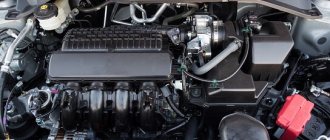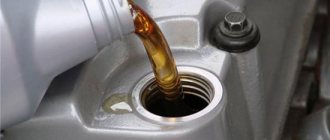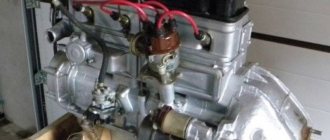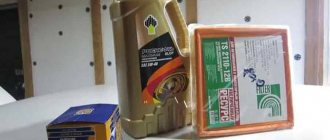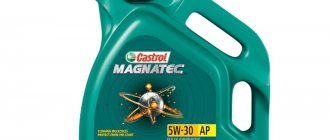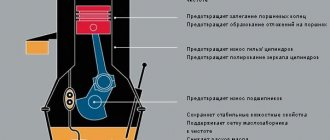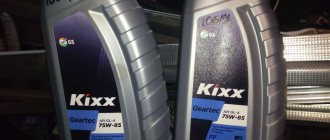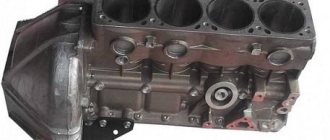The frequency of engine oil changes is determined by the maintenance regulations. However, any internal combustion engine consumes lubricants during operation. In some cars this is provided by the manufacturer.
Filling oil into a Hyundai engine
Engines with mileage or malfunctions consume motor lubricant in excess of the norm. In any case, car owners are faced with the need to compensate for the waste of lubricant.
How to add oil to the engine without causing damage to it? It would seem that everything is simple: you need to initially purchase consumables with a reserve, and add lubricant during consumption (planned or not).
However, packaging is not always rational in terms of volume, and the car owner has to overpay for extra liters, which are not always in demand.
How much oil should I add to the engine?
To control the level, an oil dipstick is provided in any internal combustion engine. It is necessary to make it a rule to check the volume of technical fluids at least once a week.
The easiest way is to do this before you start moving. If your car is in a garage or parked: before starting the engine, open the hood, remove the dipstick, and wipe it dry. Then put it back in and take it out again.
Engine oil level on dipstick
The main condition is a flat horizontal surface: if you park on a curb, the readings will be incorrect. The oil mark should be between the “MIN” and “MAX” marks. As a rule, the difference between these marks is 1 liter. It is not necessary to strictly maintain the middle; an oil trace anywhere between the marks means a normal level.
Important! Excess oil is no less harmful than too low a level. “Excess” lubricant gets onto the piston group, under the influence of temperature it separates into components, and falls out in the form of slag. Deposits clog oil channels, impairing circulation.
In addition, excess lubricant leads to an increase in pressure in the crankcase, as a result of which oil seals or gaskets can depressurize: they are simply squeezed out of their seats. Excess fluid loads the oil pump, which leads to accelerated wear.
Accordingly, a low level leads to oil starvation (the consequences can lead to unplanned overhauls).
What to pay attention to
Without motor fluid, an internal combustion engine cannot operate. Automotive oil that does not meet the tolerances is unable to protect the power unit and can lead to failure of the most important parts and components. But the motor fluid itself, which provides protection against dry friction, experiences enormous loads due to the high temperature in the engine.
Functions provided by lubricating fluid:
- minimizes the negative effects of friction, and with the help of special modifiers prevents the formation of scuffing;
- reduces wear of parts, which helps to increase the life of the power unit;
- the oil film increases compression and reduces the gap between the cylinders and piston rings;
- any basic lubricant (mineral, synthetic, semi-synthetic, esters, PAO) is designed to remove excess heat from surfaces subject to friction;
- dispersants and detergents are responsible for removing carbon deposits, sludge, and cleanliness of the power unit;
- antioxidant additives allow you to maintain the performance of the lubricant during its use;
- anti-corrosion additives increase the service life of parts, protecting them from oxidation and rust formation;
- Anti-foaming additives are responsible for the rational use of lubricating fluid.
The most important functions that lubrication provides play a major role in protecting the motor. Therefore, it is imperative to monitor its level and, if necessary, add oil to the engine.
Before you start topping up, the first thing you need to do is find out what lubricant is used in the internal combustion engine. This information is contained in the technical documentation of the car; you can also find it out from the previous owner if the car is not new. You will need motor fluid with the same viscosity characteristics, even better if the oil is of the same brand.
The topping up procedure is carried out if the mark on the oil dipstick is fixed below the “minimum” value. After stopping the car, the temperature of the internal combustion engine is very high.
It is recommended to measure the lubricant level 15-20 minutes after the engine is turned off. During this time, the entire oil mixture will drain into the crankcase. After the specified time has elapsed, a measurement is taken with a dry probe, having previously wiped it from any remaining lubricating fluid. If the oil trace is recorded between the “maximum” and “minimum” risks, there is no reason to worry.
It is not recommended to take measurements in a cold power unit, especially in frosty weather. You need to warm up the engine to get the correct result.
How to properly add oil to the engine?
- it is necessary to approximately determine the missing volume (if the mark is at the “MIN” level, it will be 0.5 l), and add fresh lubricant;
- after which you need to start the engine, let it run for 5-10 minutes, turn it off, and wait 10 minutes until the lubricant drains to the bottom of the crankcase;
- measure the level again (take out the dipstick, wipe it, insert it and take it out again).
It is enough to carry out this procedure once, and you will know exactly how much liquid is between the two marks on the dipstick.
Topping up engine oil is a guarantee of long-term engine operation.
Before adding engine fluid, you need to determine how much is in the system. To do this, turn off the engine and place the car on a level surface. The test is performed “cold”, with the engine system cooled down.
Each engine is equipped with a special dipstick, which has several marks indicating the minimum and maximum amount of oil composition.
The dipstick is removed from the crankcase and thoroughly wiped. Then it is lowered back inside the neck and the existing level is determined by the risks.
Is it possible to add oil from another manufacturer to the engine?
In principle, the brand does not determine the characteristics of lubricants. If SAE viscosity specifications and API tolerances are met, mixing will not be a major problem.
Of course, the ideal option is to have a supply of oil that you filled in during the next maintenance. But in practice this is not always possible.
The fundamental issue is the conformity of the basis. Mineral oil cannot be added to synthetic oil, and it is not recommended to mix it with semi-synthetic oil. In a critical situation, if the level drops on the road and you do not have a supply of the “correct” oil with you, you can add synthetic to semi-synthetic.
Emergency situation: the lubricant level is critically low, it is impossible to select the correct consumable.
In this case, fill in any oil that is as close as possible in terms of characteristics. Here we choose the “best of two evils”: without oil, the engine will definitely fail, but with the “wrong” lubrication you can make it to a service station.
The main thing is to drive at low speeds without overloading the power plant. When you get to the place where you can service the car, immediately change the oil, if possible, flushing the engine.
Step-by-step instruction
- Determine what oil can be added to the engine. In the car's passport, the manufacturer gives recommendations on the brand and viscosity of materials.
- Turn off the engine and leave it for several hours. During this time, both the engine itself and the oil will cool down to ambient temperature. Liquid from the walls will drain into the pan.
- Open the oil filler neck located at the top of the cylinder block. It is easy to find under the hood by the characteristic pictogram - an oil can with a drop.
- Insert a funnel into the neck. If the device is not in the trunk, you can make it yourself. To do this, cut off the top of the plastic bottle and insert it upside down into the container.
- Add oil to the optimal level. Check the amount of fluid with a dipstick.
- Close the neck with a lid and wipe all parts with a rag.
When to add oil to the engine?
The question is rather rhetorical. Of course, immediately after detecting a low level. As a rule, the car owner knows what the car's lubricant consumption is. By regularly looking at the odometer, you can accurately determine the need to replenish the volume. At the same time, no one canceled regular monitoring.
If there are 1000-1500 km left before the next scheduled maintenance, there is no point in wasting fresh engine oil on topping up. Perform maintenance ahead of schedule. At the same time, you should purchase new oil with a reserve, since you know exactly how much fluid will have to be added during the service period.
Typical rookie mistake
Often inexperienced drivers fill in as much engine oil as possible, believing that this will be better. Overfilling in excess of the norm is not only undesirable, it can harm the car engine. The danger lies in the following aspects:
- oil has a certain viscosity, and their quantitative excess impairs engine crankability. This results in maximum fuel consumption;
- When heated, liquids expand and the pressure they exert increases. Excess oil mixture leads to squeezing out gaskets and seals;
- cold starting of the engine is difficult;
- excess carbon deposits and “bedding” of rings;
- excessive foam formation.
Not adding enough oil also has negative consequences:
- friction increases, chips form on the crankshaft;
- Over time, the cylinder pistons become jammed.
Topping up rules
First, you need to find out what brand of oil was poured into the engine. When selling a car, the former owner usually reports what type of oil he used. All that remains is to purchase an analogue with the desired viscosity coefficient.
Topping up is carried out only when the oil level “on the dipstick” does not reach about. When performing such a check, remember that if the engine is hot, the oil has not completely drained into the crankcase. When the engine cools down, the lubricant level will be higher. Therefore, to obtain accurate data, you must wait until the unit cools down. 15-20 minutes is enough.
In winter, to check the level, experts advise slightly warming up the internal combustion engine. The fact is that in cold weather the oil begins to freeze, and after heating the volume will increase slightly.
Using quality lubricants
- The use of proven motor lubricants can significantly increase the operating time of a car engine. Also, branded lubricants support the machine’s engine at the most optimal level in all key indicators.
- For standard gasoline engines, I would recommend Shell 5W20 series lubricants, which can be replaced quite easily and which practically do not become dirty during operation.
Shell lubricants are light in color. These lubricants are the highest quality products from the entire company series and can be used on any car. I would note its high environmental friendliness and the fact that the product practically does not leave scale on the cylinders after operation. Also, the lubricant does not create soot during operation. The only drawback of the product is its rather high cost.
At its core, this automobile oil is perfect for the operation of engines of almost all cars. It is used in all-wheel drive cars of Mercedes and other brands, and can also be poured into cars of domestic brands. The lubricant can be used in manual transmissions and internal transfer cases, but only if the manufacturer has specified the use of the 5w90 class.
To change the lubricant in a car, you should do the following:
- Place your car with a warm engine in a garage pit or on an overpass, if you have one. Next, simply open the hood and remove the neck from the engine drain hole.
- At the same time, place an empty container under this neck, then manually unscrew the drain cap.
- When everything goes out, carefully pour new clean oil into it and turn on the engine. Also, don’t forget to fill the engine with oil through the filler neck. What to do next? Just turn the cap and screw it back to its original position - back.
- At the end of the procedure, all you have to do is turn on your car and check that the pressure level warning light has stopped lighting.
- I also hope it will not be a discovery for you if the lamp does not light up when you turn on the engine for the first time. Typically, the system needs about 20 seconds for the motor to develop the pressure necessary for its operation.
This is interesting: What is the real consumption of the Kia Rio
Consequences of excess and deficiency
The limits within which the liquid level should be were described above. But what consequences can occur with an excess or lack of mixture, we will analyze further.
Overflow
Some car enthusiasts believe that if there is an excess of the mixture, it will not harm the vehicle. But this is a misconception. The engine mixture has a certain viscosity and in case of overflow, the resistance to any movements will become even greater. The consequences of this are increased fuel consumption. This is the most harmless thing that can happen.
There are other consequences:
- contamination of all spaces under the hood and replacement of seals;
- difficulty starting the engine during frosts;
- oil starvation of engine elements caused by foaming of the composition;
- the formation of a large amount of carbon deposits, the appearance of coke inside the cylinder-piston group, and the “occurrence” of rings.
Underfilling
But not only an overflow of fluid can harm the engine, but also a lack of it. In this case, the mixture either does not arrive at all, or arrives, but in very small quantities.
Another trouble is the formation of air pockets inside the liquid that will move through the channels.
How to determine how much oil is in the engine
A lot depends on how much oil is in the engine. It is described above within what limits this level should be. But let’s look at how to check it in more detail.
Vacuum express oil change
Many service stations offer quick oil changes using a vacuum oil change unit. With this method, a thin tube is inserted into the dipstick hole and the oil is sucked out of the engine. When changing the oil vacuum, neither a lift nor a pit is needed, there is no need to remove the crankcase protection, and there is no need to unscrew the engine crankcase drain plug. Oil changes are much faster and cheaper.
The disadvantage of a vacuum oil change is that much more old used motor oil remains in the engine than with a traditional oil change using the drain method. During vacuum replacement, metal shavings, dirt, and oil clots remain in the engine sump. Changing the oil in the classic way with draining the old oil through the crankcase drain plug is better for the car engine.
Lubrication System - Brief Overview
One of the most important parts of a car engine is the mechanism for lubricating it - the so-called lubrication system. This system is able to effectively protect all internal elements of the machine from wear. To ensure stable and trouble-free operation of the entire engine lubrication mechanism over a long period of time, I advise you to carefully monitor its technological condition throughout all years of operation. Also try to fill it with new lubricant on time or change it to clean one.
In this article, I tried to tell you how you can independently control the amount of oil in the engine lubrication system, and also wrote about the consequences of neglecting this. What can happen if you increase or decrease the amount of lubricant in the lubrication system, I also tried to clearly explain how to correctly change the lubricant in a car engine.
So, let's start by checking the condition and amount of lubricant in the system. Some car owners of recently purchased cars do not understand at all and are not even aware of the consequences of incorrect actions when changing the lubricant. They don’t know how to properly fill the engine with lubricant when driving their car after purchasing it to the first service station.
But why spend money on maintaining your car if you can do everything yourself? At the same time, relying on the warranty from the manufacturer, they quickly forget the main tenets of car maintenance and cease to understand the basic principles of filling oil. They also do not take into account the fact that in the machine operating book all the basic tips for maintaining machine elements are clearly indicated.
By the way, it’s worth checking the lubricant level in the engine from time to time (this must be done once every 12-15 days), especially during long trips.
Important to consider! In order for you to avoid inaccurate information about the amount of lubricant in the engine, you should only check it cold.
This is interesting: How to dilute coolant concentrate
